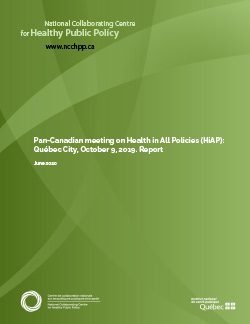Pan-Canadian meeting on Health in All Policies (HiAP): Québec City, October 9, 2019 - Report
Health in All Policies (HiAP) is an increasingly important approach for systematically addressing the social determinants of health at all levels of government. HiAP refers to “an approach to public policies across sectors that systematically takes into account the health implications of decisions, seeks synergies, and avoids harmful health impacts in order to improve population health and health equity”.1
In Canada, HiAP is on the radar of several governments, organizations and networks. Advocacy for and the momentum of a HiAP approach has been building, drawing attention to the potential impacts of this approach. Yet challenges to implementation exist across jurisdictions, including the use of a shared language, conflict of interest between sectors, and the need to ensure sustainability. Despite a clear interest, there are few spaces to share and learn from various Canadian and international initiatives and thus accelerate the dissemination and adaptation of promising innovative practices and proven practices.
Against this backdrop, the National Collaborating Centre for Healthy Public Policy (NCCHPP) organized a Pan-Canadian Meeting on Health in All Policies (HiAP) in partnership with the Public Health Agency of Canada (PHAC) and the Ministère de la Santé et des Services sociaux (MSSS) du Québec in Québec City, on October 9, 2019. This meeting was a side event of the Second Meeting of the Global Network for Health in All Policies (GNHiAP) that was held from October 7 to 9, 2019.
The objectives of this meeting were the following:
- Support networking among Canadian stakeholders interested in HiAP.
- Share experiences related to:
- what HiAP means for the participants;
- the status of HiAP in Canada including in Indigenous contexts; and
- examples of Canadian HiAP initiatives.
- Explore pathways for supporting HiAP practice in Canada.
Three main themes related to HiAP implementation in Canada were discussed at the meeting:
- How can we put HiAP on the agenda of the different levels of government?
- What are the needs in terms of HiAP support / capacity building?
- What could be the roles of the federal, provincial, territorial and Indigenous governments in supporting the implementation of HiAP in Canada?
From the meeting, it was determined that HiAP is an important and useful approach, deserving of broader recognition, common understanding, and uptake across Canada. To further that goal, participants identified the following key areas for action:
Build the evidence base to support capacity building and implementation
- Synthesize knowledge of HiAP initiatives – and intersectoral initiatives related to HiAP – across Canadian jurisdictions, including information on context, implementation issues and strategies, and tools.
- Compare Canada’s performance to that of other nations that have implemented HiAP initiatives and evaluate the effectiveness of different HiAP initiatives.
- Develop toolkits and learning modules to support jurisdictions in HiAP implementation.
Lay the groundwork for a common understanding of HiAP across sectors
- Develop a common language and key messages that resonate in sectors outside of health, to support HiAP practice.
- Identify key elements in different jurisdictions that contribute to legitimizing public health interventions in intersectoral/whole-of-government initiatives led by other sectors.
- Develop strategies to incorporate a complementary vision for “Indigenous Rights in All Policies” within HiAP initiatives.
- Foster research for producing data and scientific evidence to document the links between health and other government policies.
Launch an intersectoral HiAP network for Canada
- Create a Canadian network composed of intersectoral partners from various settings (e.g., universities, Indigenous organizations) and link to the GNHiAP.
- Explore adaptation of the WHO’s HiAP Framework for Country Action2 to the Canadian context, to guide network activities and goals.
- Organize additional pan-Canadian meetings on HiAP in Canada.
The participants in the HiAP Pan-Canadian Meeting identified HiAP as an essential approach to improving population health and health equity. They highlighted their willingness to continue discussions and exchanges on the subject. As the proposed areas for action above highlight, there are several opportunities for governments and organizations to work together at all levels towards HiAP implementation. Opportunities for partnership between sectors will be explored and strengthened as the NCCHPP, partner organizations and HiAP actors support this work across Canada.
1 World Health Organization [WHO]. (2013). The Helsinki Statement on Health in All Policies. 8th Global Conference on Health Promotion, Helsinki, Finland, June 10-14, 2013. Retrieved from: https://www.who.int/healthpromotion/conferences/8gchp/8gchp_helsinki_statement.pdf
2 World Health Organization [WHO]. (2014). Health in All Policies: Framework for Country Action. Geneva, Switzerland: WHO. Retrieved from : https://www.who.int/healthpromotion/frameworkforcountryaction/en/


